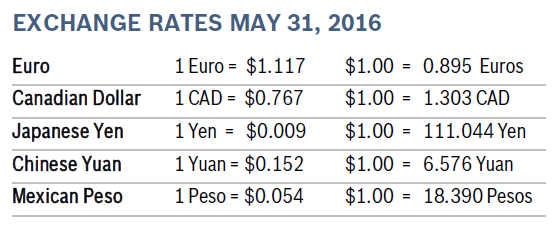 U.S. ECONOMY MARKET WATCH MAY 31, 2016 Markets struggled to find direction during the month of May, but closed modestly higher. The DOW gained 0.1% to close at 17,787, the NASDAQ rose 3.6% to 4,948 and the S&P, the index most closely followed by economists, rose 1.5% to close at 2,097. CONSUMER CONFIDENCE DROPS TO 92.6 The New-York based Conference Board’s Consumer Confidence Index fell to 92.6 in May after dropping to a slightly upwardly revised 94.7 in April. The Present Situation Index dropped to 112.9 from an upwardly revised 117.1 in April. The Expectations Index fell to 79.0 after dropping to an upwardly revised 79.7 in April. The Conference Board said that the decline was due to consumers’ less optimistic view of current conditions. Economists say a level of 90 indicates that the economy is on solid footing and a level of 100 or more indicates growth. Analysts caution that the real driver behind consumer spending is income growth and that labor market trends are a more accurate predictor of consumer behavior. CONSUMER SPENDING RISES 1.0% Consumer spending rose 1.0% in April after being flat in March. It was the biggest increase in more than six years. Incomes rose a solid 0.4% after rising by the same amount in March. Adjusted for inflation, consumer spending rose a solid 0.6%. The personal savings rate fell to 5.4% from 5.9% in March, and was the lowest level of the year. Core PCE (personal consumption expenditures) prices, the Federal Reserve’s preferred inflation measure, rose 0.3% in April after rising 0.1% in March, and were up 1.1% year-over-year, still below the Fed’s target of 2%. Consumer spending is closely watched by economists because it accounts for 70% of U.S. economic activity. CONSUMER PRICES RISE 0.4% The Consumer Price Index (CPI) rose 0.4% in April after rising 0.1% in March. It was the fastest pace in more than three years. In the 12 months through March the CPI increased 2.1%. The increase was primarily due to an 8.1% increase in the price of gasoline. Core prices, which strip out volatile food and energy costs, rose 0.2% in April after rising 0.1% in March. In the 12 months through April core inflation was up 2.1%, the fifth consecutive month of growth of 2.0% or more. Oil prices have moved higher in recent months, and the dollar has weakened against global currencies, allowing inflation to move into a range that the Fed considers acceptable. UNEMPLOYMENT FALLS TO 4.7% The unemployment rate dropped to 4.7% in May from 5.0% in April but the economy added just 38,000 jobs, far below expectations of 158,000 new jobs. In addition, April’s job gains were reduced to 123,000 from 160,000 and March gains were trimmed to 186,000 from the 208,000 new jobs originally reported. Employment in construction and retail was little changed. Analysts noted that the strike at Verizon affected employment numbers overall. In May, average hourly earnings for all employees on private nonfarm payrolls increased by 5 cents to $25.59, following an increase of 9 cents in April. Over the year, average hourly earnings have risen by 2.5%. The report raised fresh concerns about the stability of the economic recovery. It was the lowest level of jobs created since 2011. Average hourly wages rose 0.2%. DURABLE GOODS ORDERS RISE 3.4% New orders for durable goods rose 3.4% in April, and gains for March were revised from 0.8% to 1.9%. The big jump in orders was primarily attributable to a 64.9% leap in aircraft orders, a notoriously volatile category. Orders for non-defense capital goods excluding aircraft, a category that serves as a proxy for business investment spending, fell 0.8% after being unchanged in March. Shipments of core capital goods, which factor into GDP calculations for business spending, increased 0.3% in April after rising 0.3% in March. The durable goods report is often both volatile and subject to sharp revisions. Oxford Economics expects that the headwinds that are constraining growth, including the strong dollar, weak foreign demand, bloated inventories and low oil prices, will remain for much of the year and limit real GDP growth this year. CHICAGO PMI FALLS TO 49.3 The Chicago PMI fell 1.1 points to 49.3 in May after falling to 50.4 in April. It was the lowest level since February and the sixth time the PMI has been in contraction over the past 12 months. The decline was led by a big drop in Production, which fell below 50, as well as a drop in New Orders. Inventories fell by more than ten points to the lowest level since November 2009. It was the seventh consecutive month Inventories have been in contraction, which could signify some uncertainty about future business growth. A special question posed to the panel showed that 68.7% of respondents did not plan to increase business investment over the next six months. WHOLESALE PRICES RISE 0.2% The Producer Price Index (PPI) rose 0.2% in April after falling 0.1% in March and was unchanged from April 2015. The core PPI, which excludes food, energy and trade services, rose 0.9% after falling 0.1% in March and was up 0.9% from April 2015. Economists had expected a 0.3% increase. Producer prices for personal consumption, a proxy for consumer inflation, rose 0.2% in April and were up 0.2% year-over-year. The PPI for inputs to construction rose 0.3% in April after rising by the same amount in March but was down 1.7% from April 2015. Q1 GDP REVISED UP TO 0.8% GDP grew an upwardly revised 0.8% in the first quarter, up from the 0.5% growth first reported, but still below economists’ expectations. GDP grew 1.4% in the fourth quarter. Compared with the first report, the latest figures showed a larger gain for residential investment and a smaller drag on overall growth from private inventories and foreign trade. The second report also offered the first official estimate of U.S. corporate profits during the first quarter, which rose 1.9%. Consumer spending, which accounts for about 70% of economic activity, grew 1.9% in the first quarter, unchanged from the initial estimate, which was the weakest showing in a year. Outlays on new home construction jumped 17.1%, up from the prior estimate of 14.8% and the biggest gain in nearly four years. The value of inventories rose from the $60.9 billion first reported to $69.6 billion. Business investment in all other categories declined. Inflation was unchanged, with the PCE (personal consumption expenditures) index rising at a 0.3% annual pace. Most other categories were little changed. However, since the recovery began nearly seven years ago, GDP has been weak in the first quarter of each year, averaging 0.8%, and has then rebounded in the spring, with second quarter growth averaging 3.1%. Economists are expecting a similar pattern this year, forecasting second quarter growth of between 2.3% and 2.8%. JOB OPENINGS RISE Job openings increased by 149,000 to 5.75 million in March, according to the latest Job Openings and Labor Turnover Survey, or JOLTS report. The gain lifted the jobs openings rate to 3.9% and upward revisions to prior data showed that openings rose in February compared to the initially reported decline. Hires edged down to 5.29 million in March. The renewed gap between openings and hires could indicate a tightening labor market, with job vacancies harder to fill. Total separations fell to 5.05 million in March, Quits rose slightly and layoffs continued to fall. Quits are typically voluntary separations, and an increase in quits generally indicates that people are more confident about their ability to find another job. The JOLTS report is one of Fed Chair Janet Yellen’s preferred economic indicators. FED FORECASTS SECOND QUARTER GROWTH The Atlanta Fed reported that its GDPNow model forecast for real GDP growth in the second quarter jumped to 2.8% in mid-May from the previous forecast of 1.7% growth. They also increased the forecast for consumer spending for the second quarter from 2.6% to 3.0% and increased the projection for fixed investment growth from 0.4% to 2.2%. The government won’t release its actual estimate of second quarter growth until the end of July. YELLEN INDICATES RATE HIKE LIKELY Fed Chair Janet Yellen confirmed that the Fed will most likely raise interest rates in the coming months if the economy continues to improve as expected. She did not commit to whether the first rate hike since the Fed raised rates a quarter-point last December would come in June or July but said that the economy is picking up after a weak first quarter. Fed policymakers have indicated that they expect to raise rates twice this year. Wells Fargo expects that the first increase will come in the third quarter. © Robert Bosch Tool Corporation. All rights reserved, no copying or reproducing is permitted without prior written approval. Comments are closed.
|
|







